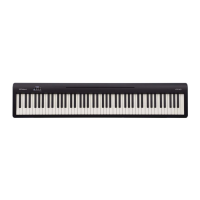54
Menu Options
Parameter Explanation/Value
Volume
(Volume)
This parameter allows you to set the
Orchestra section’s volume.
This setting is a value relative to the
standard "Std" setting.
Off, –40–Std–40
Panpot
(Panpot)
Depending on the selected sound, this
parameter allows you to change the
Orchestra part’s placement in the stereo
sound field (i.e. between the left and
right speakers) to create a livelier sound
image.
The “TR” (Treble) values mean that the
sound will appear on the same side as the
Right Hand (treble) accordion sound. This
setting applies to both the FR-4x internal
speakers and the L/MONO jack.
The “BS” values mean that the sound
will appear on the same side as the bass
accordion sound. This setting applies to
both the FR-4x internal speakers and the
R/ MONO jack.
BS63–0–TR63
Rev Send
(Reverb Send)
Cho Send
(Chorus Send)
Use these parameters to set the Reverb
or Chorus send levels (how much effect
should be applied to the Orchestra
section).
0–127
0–127
Attack
(Attack time)
This parameter adjusts the onset of the
sound.
Negative values speed up the attack, so
that the sound becomes more aggressive.
MEMO
The envelope parameters affect both the
volume (TVA) and the filter (TVF).
-64–0–+63
Decay
(Decay time)
This parameter adjusts the time over
which the sound’s volume and cutoff
frequency fall from the highest point of
the attack down to the sustain level.
MEMO
The envelope parameters affect both the
volume (TVA) and the filter (TVF).
-64–0–+63
Release
(Release time)
This parameter adjusts the time over
which the sound will decay after the note
is released until it is no longer heard.
The cutoff frequency will also fall
according to this setting.
MEMO
The envelope parameters affect both the
volume (TVA) and the filter (TVF).
-64–0–+63
Parameter Explanation/Value
Cutoff
(Cutoff)
This filter parameter allows you to make
the selected sound darker or brighter.
Positive settings mean that more
overtones will be allowed to pass, so that
the sound becomes brighter.
The further this value is set in the
negative direction, the fewer overtones
will be allowed to pass and the sound will
become softer (darker).
NOTE
For some sounds, positive (+) Cutoff settings
will cause no noticeable change because
the pre-programmed Cutoff parameter is
already set to its maximum value.
-64–0–+63
Reso
(Resonance)
When the Resonance value is increased,
the overtones in the area of the cutoff
frequency will be emphasized, creating a
sound with a strong character.
NOTE
For some sounds, negative (–) Resonance
settings may produce no noticeable change
because the Resonance is already set to the
minimum value.
-64–0–+63
Vib Dly
(Vibrato Delay)
This parameter adjusts the time required
for the vibrato effect to begin.
Positive (+) settings increase the time
before vibrato will begin and negative
settings shorten the time.
-64–0–+63
Vib Dept
(Vibrato Depth)
This parameter adjusts the strength of
vibrato (pitch modulation).
Positive (+) settings mean that the
“wobble” becomes more prominent,
while negative (–) settings make it
shallower.
-64–0–+63
Vib Rate
(Vibrato Rate)
This parameter adjusts the speed of
vibrato (pitch modulation).
Positive (+) settings make the preset
pitch modulation faster and negative (–)
settings make it slower.
-64–0–+63
Bel Dtne
(Bellows Detune)
This parameter allows you to specify how
strongly the orchestral sound’s pitch
should be influenced by opening and
closing the bellows faster than usual.
If the “Standard” setting seems too mild,
try “High.” If it is too strong, use “Low.”
If you do not want any detuning effect,
select “Off.”
The most convincing setting usually
depends on the selected sound.
Off

